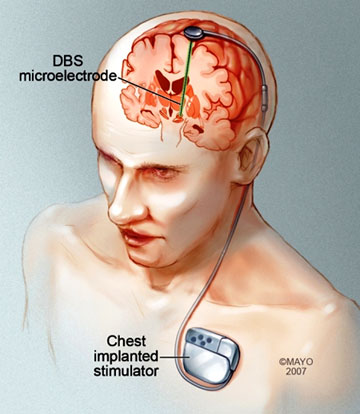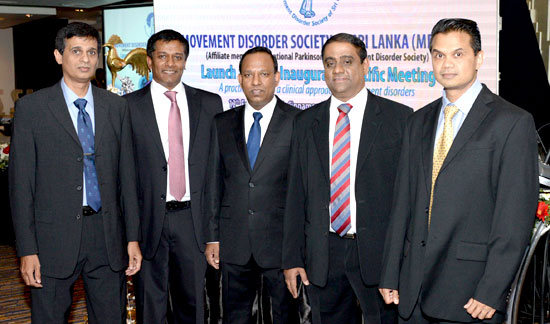Jerky limb spasms can be controlled with treatment
New hope for those suffering from movement disorders
:
by Carol Aloysius
The growing number of persons with limb disorders, such as tremors,
muscle spasms, and other neurological diseases including Parkinson's
disease in recent years, has prompted specialists in the field to launch
a Movement Disorders Society.
 |
|
Stereotactic
and functional neurosurgery has ushered in state of the art
technologies for the treatment of movement disorders, and, deep
brain stimulation (DBS) has risen to the forefront as a highly
effective, safe, and reversible treatment for these conditions. |
The Chairperson of this fledgling Society, Consultant Neurologist,
National Hospital , Sri Lanka, Dr Bimsara Senanayake, in an interview
with the Sunday Observer, discusses how the new service with its
sophisticated technologies, can help thousands of people in our country
unable to lead a normal life due to crippling limb disorders.
Excerpts...
Q. You are the Chairman of the Movement Disorders Society launched
early this year. Why was this Society formed?
A. We officially launched the Movement Disorders Society of Sri Lanka
(MDSSL) in February 2016 in Colombo. We received the affiliate status of
the International Parkinson's and Movement Disorders Society in early
2015, and now we are a fully fledged affiliate member.
The Society was launched because movement disorders are common and
affect thousands of Sri Lankans. As the diagnosis is largely dependent
on clinical examination and pattern recognition it could be a
challenging task even to neurologists. This professional/ academic body
was set up essentially to update knowledge on movement disorders among
member neurologists, and disseminate that knowledge to physicians and
other allied health personnel, while educating the public and promoting
research in this field. Our final goal is to provide the best available
care to the Sri Lankan patients
Q. What kind of diseases do you deal with?
A. Movement disorders, particularly Parkinson's disease (PD), tremor,
and dystonia, rank among the commonest neurological diseases, with
Parkinson's disease as the second commonest neurodegenerative disease
affecting over 10 million worldwide, and expected to double by 2040 with
population aging. We treat mainly Parkinson's disease (PD) and tremor or
shaking, in addition, dystonia, that is, spasm of muscles with twisting
and pain. Dancing movements are called chorea or ballism. They can occur
in Huntington's disease and even in stroke. Some have funny facial
movements like tics, twitching eyelids (blepherospasm), or jerky limb
movements. Accurate diagnosis is the cornerstone for predicting
prognosis and the planning of management.
Q. To those of us who are still unfamiliar with many of these
diseases could you tell us more about them and their symptoms? Who are
the most vulnerable?
A. Parkinson's disease and tremor predominantly affect the elderly,
but young onset cases are also seen. In the common idiopathic variety
the dopamine producing cells in the brain are damaged due to an unknown
cause. There can be many causes for this cellular damage in the brain,
especially, in the young onset cases, e.g. copper deposition (Wilson's
disease), iron deposition (neuroferritinpathy), calcium deposition (Fahr's
disease, low blood calcium), ischemic damage, and genetic causes. If
such a cause is found we can sometimes completely reverse the process.
Q. What is chorea? What are the symptoms?
A. Chorea is an abnormal involuntary movement disorder. The term
chorea is derived from a Greek word, meaning dance. In chorea the quick
movements of the feet or hands are comparable to dancing. There are many
causes. Huntington's disease (HD) is the commonest in the older patients
while rheumatic (Sydenham's chorea) is seen in children with rheumatic
fever. Pregnancy, drugs, thyroid disease also can cause chorea
Q. Are they all neurological diseases? Who should one see to get a
proper diagnosis? A general neurologist, or a specialist in movement
disorders? Why?
 |
|
The Founders of MDSSL: Dr
A T Alibhoy (Treasurer), Dr Arjuna Fernando, Dr Darshana
Sirisena (Secretary), Dr Bimsara Senanayake (Chairman), Dr
Thashi Chang |
A. Good question. Movement disorders are neurological illnesses.
Hence, the best specialist to see is a neurologist. Neurologists with
special interest in movement disorders would be even better as regards
diagnosis and initiating appropriate management.
Q. Can a person lead a normal life and drive a car, tech or do a
normal job with one of these diseases?
A. If well controlled, they can lead near normal lives. However, some
of these conditions can get worse progressively with time, needing
assisted care. Accurate diagnosis is the cornerstone of predicting
prognosis as I mentioned earlier.
Q. Can they be inherited via one's genes?
A. Yes they can. A small percentage of PD is inherited via genes
while almost 50% of patients with essential tremor get it from their
parents. Huntington's disease is genetically inherited. Genetics play a
major role as a cause in many movement disorders
Q. If so, are there genetic testing and genetic counselling available
in Sri Lanka for such persons?
A. Unfortunately, we are still way behind the developed world in
movement disorder genetic testing. Currently, we are looking at
establishing collaborations with centres of excellence abroad to enable
us to test our patients and families. We do test some patients on a case
by case basis with our currently available links.
Q. Are they life threatening? Can they cause death if neglected?
A. Well, most of them are not life threatening. However, early death
can occur in PD and related conditions due to complications such as
swallowing difficulty, aspiration pneumonia, falls, etc. Conditions such
as ET are more benign but functionally disabling.
Q. What is the treatment procedure?
A. The treatment of movement disorders depends on the diagnosis. PD
can be reasonably well controlled with the currently available
medications. What we can do is, alleviate the symptoms of the patient.
The disease progression is not arrested with currently available
drugs. We give them what they lack in their brain, namely, dopamine, a
neurotransmitter in a form that crosses the blood brain barrier. There
are other drugs that facilitate this process. These drugs are not
without side effects and sometimes when treated for many years causes
dyskinesia and fluctuations.
Q. If they need to be on drugs, where can needy persons obtain them
at reduced rates or free of charge? Are they available at all leading
state hospitals?
A. Most anti PD drugs are available in Sri Lanka. In the state
hospitals the main medication levodopa is available but not everything
else. In general, drugs used for movement disorders are not very
expensive. However, certain special medications like botulinum toxin
injections can be more expensive.
Q. Is surgery an option? If so in what instance?
A. Yes a surgical option is available for some specific cases. Deep
brain stimulation (DBS) is the main surgical procedure. DBS involves
implanting electrodes within certain areas of the brain. These
electrodes produce electrical impulses that regulate abnormal impulses,
or the electrical impulses can affect certain cells and chemicals within
the brain. The amount of stimulation is controlled by a pacemaker-like
device placed under the skin in the upper chest. A wire that travels
under your skin connects this device to the electrodes in the brain. DBS
is very effective in some cases, but costly.
Q. What are the risks of surgery?
A. Side effects associated with DBS may include: Seizure, Infection,
headache, confusion, stroke and hardware complications, such as an
eroded lead wire, temporary pain and swelling at the implantation site
Q. What about alternative cures like herbal medicines?
A. No clinically proven benefit as far as I know
Q. Can physical therapy help alleviate symptoms?
A. It can improve mobility and the general well being, but
essentially does not alter the progression of these diseases
Q. How many persons world wide suffer from movement disorders? Has
there been a study worldwide?
A. Again, depends on the type of movement disorder. An estimated
seven to 10 million people worldwide are living with Parkinson's disease
with the numbers expected to double by 2040, due to aging.
Q. What about Sri Lanka? Has there been any study? Or do you plan to
conduct one in the near future?
A. Unfortunately, like with most diseases, we in Sri Lanka do not
have our own epidemiological data on these diseases to give the actual
prevalence and incidence. But, it seems to be comparable to the rest of
the world. We hope our own epidemiological data would be available in
the future
Q. Do most of these diseases need long term care? If so where can
needy patients get support? In rehabilitation centres? Hospices? How
many do we have? Are they enough? Do we have enough psychologists and
psychiatrists to tend to those who are mentally stressed by these
diseases?
A. Yes, they do need long term care. In Sri Lanka, unfortunately, we
do not have proper neuro rehabilitation facilities for most of the
patients with chronic neurological disease. A network of intermediate
care centres, such as, hospices are also generally not available here.
An area we need to improve immensely in the future.
Q. What are the most pressing needs of people with chronic or long
term movement disorders in the country?
A. A proper diagnosis is a must. It is important to get the patient
seen by a neurologist. Investigative tool such as, MRI, PET, and DAT
scanning can enhance diagnostic accuracy. Genetic studies are extremely
important in these cases. We do not have a specialized neuro-genetic
service which can help with movement disorder genetics. Drugs, access to
surgery and rehab facilities are important needs.
Q. How do you propose filling these gaps?
A. Through international collaboration with centres of excellence.
Q. What are the most recent breakthroughs in any of these diseases?
A. Stereotactic and functional neurosurgery has ushered in state of
the art technologies for the treatment of movement disorders, and, deep
brain stimulation (DBS) has risen to the forefront as a highly
effective, safe, and reversible treatment for these conditions.
Q. Finally, your message to patients and care givers?
A. Have hope. There are significant advances made in this field over
the last 10-15 years. Although a complete cure may not be possible in
all cases, an accurate diagnosis and treatment can give you a better
quality of life. |

